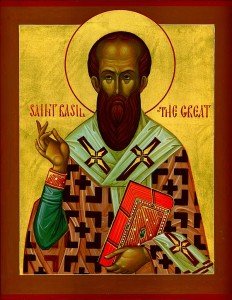I will, because of the Great Fast, temporarily discontinue my thoughts on the Divine Liturgy of John Chrysostom and begin sharing thoughts about the two regular worship services we use during this time, namely the Liturgy of the Presanctified Gifts and the Liturgy of Basil the Great. Our Church directs us to use these two liturgical services during Lent.
 As we know from history, there were, in the early Church, very few and well tested people who could be considered as true Christians. There were not vast numbers of people who belonged to the Jesus movement. There were only small groups of people who met in homes and shared the faith and the Eucharist. There existed, as a result of these small numbers, a real practice of giving Holy Communion to the faithful at the end of the Sunday Eucharist for their daily, individual communion at home. In this way the joyful Eucharist of the Lord’s Day was extended to the entire week. This noble practice was discontinued with the growth of the Church. This practice was discontinued for fear of possible misuse of the Holy Gifts. In the West this led to the appearance of the daily Liturgy and the festal character of the Eucharist ceased. This caused a change, in the West, to the Church’s understanding of the Eucharist.
As we know from history, there were, in the early Church, very few and well tested people who could be considered as true Christians. There were not vast numbers of people who belonged to the Jesus movement. There were only small groups of people who met in homes and shared the faith and the Eucharist. There existed, as a result of these small numbers, a real practice of giving Holy Communion to the faithful at the end of the Sunday Eucharist for their daily, individual communion at home. In this way the joyful Eucharist of the Lord’s Day was extended to the entire week. This noble practice was discontinued with the growth of the Church. This practice was discontinued for fear of possible misuse of the Holy Gifts. In the West this led to the appearance of the daily Liturgy and the festal character of the Eucharist ceased. This caused a change, in the West, to the Church’s understanding of the Eucharist.
In the East the initial, eschatological, Kingdom-centered, joyful understanding of the Eucharist was never given up and the Liturgy, even to this day, is not a mere part of the daily cycle. Its celebration is always a feast and always acquires a spiritual connotation of the Lord’s Day. The celebration of the Eucharist, therefore, is incompatible with fasting and is not served on weekdays of the Great Fast. Thus, once the daily Communion at home was discontinued, it was not replaced in the East with the daily celebration of the Eucharist but gave birth to a new form of Communion with the Gifts reserved from the Sunday, festal celebration.
It is likely that the first Presanctified Liturgy was not limited to the Great Fast but was common to all fasting seasons of the Church. As the number of feasts increased, the celebration of the Holy Eucharist became more frequent. This meant therefore, that the Presanctified Liturgy became characteristic of the liturgical feature of the Great Fast. The Presanctified Liturgy is the Eastern Church’s liturgical service of Lent.
